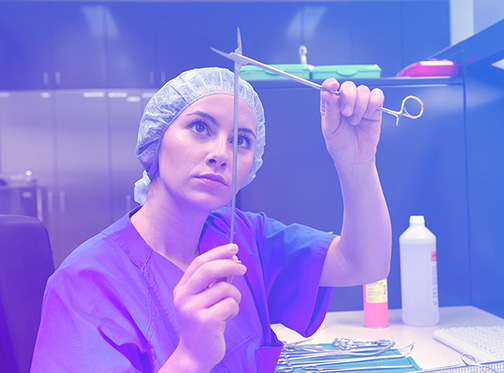With St. Patrick’s Day occurring this month, you may think about shamrocks, leprechauns, wearing green, and luck. Being lucky is a wonderful thing, but you can’t count on luck when it comes to producing quality items that are safe to handle and safe for patient use. If you’re incorrectly processing an item, don’t have the tools to do your job, or lack personnel, there’s a chance your instruments will not be ready for surgical use. But when it comes to life and limb, no one wants to take a chance or count on luck.
We all hear the stories of the unintended consequences of surgical procedures, and we dread having our facility in the news due to a processing mishap. But the reality is that it’s happening and can happen to anyone with one missed step. Producing a quality item is a cycle that never ends. From point of use to decontamination, assembly, sterilization, and storage, there are steps that must occur. For some items, there are critical additional steps.
Point of Use
At point of use, the instruments should be kept clean throughout the surgical procedure and treated with a cleaner that will keep the instruments moist until the sterile processing department can clean them in decontamination. When it comes to cleaning, we all know the instruments need to be soaked, flushed, brushed, and taken apart, but there are other factors to consider. The correct cleaner, the cleaner-to-water ratio, temperature of the water, and washers correctly operating are some of the factors that affect the quality of a clean instrument. You can hope everything is correct, but unless you’re following the instructions for use (IFU) and/or testing efficacy, you’re solely relying on luck.
Assembly
When assembling a container or peel-packing an instrument, the instrument is inspected for cleanliness and functionality, but what about the IFU required testing? Are all lumens inspected with a borescope? Are all laparoscopic insulated items tested? What about instrument sharpness? And if you are completing these required tasks, where and how are you documenting them? If you didn’t document it, it didn’t happen. There’s a lot more to just putting the correct instrument in the correct set. It’s estimated that every 90 minutes someone is burned from a laparoscopic procedure and those burns most likely could have been prevented had someone taken 30 seconds to test the insulation.1 30 seconds could mean a matter of life or death or preventing serious injury. Taking the time to do what’s required and documenting that it was completed is a critical step in assembling a container. You can’t rely on luck, not test your instrument, and hope your instrument is okay. Luck is when the instrument passes the test or inspection because now you don’t have a repair expense or instrument that can’t be used.
Sterilization
Sterilization may be the trickiest part of the process. With so many IFUs providing varying sterilization methods, building a set and determining the sterilization parameter that is correct for every item in the container can be challenging. Gone are the days of “we just run everything on 270/4/45.” All it takes is one instrument that has an IFU that states 10-minute exposure and you’re noncompliant with an instrument that may not be sterile. The flip side to that is you can’t just run everything on a 10-minute exposure because some instruments require no more than a 4-minute exposure due to the integrity of the instrument material. Considering updates and changes to IFUs, and verifying the sterilization parameters you have assigned to a set should be conducted on a predetermined basis. For some facilities, this is annual. An IFU can change, and there is no rule or regulation stating that the manufacturer must notify everyone who has purchased that item of the update. If you’re not verifying sterilization parameters, you’re going on faith that they haven’t changed. And while yes, you’re lucky if they haven’t, if they have, you may be supplying your customers with an unsterile or unsafe item.
Storage
Storage comes with many options and definitions: sterile storage in restricted areas, clinic storage in unrestricted areas, and how items are stored. Just because it’s sterile storage in a restricted area doesn’t necessarily mean environmental parameters are always maintained. If wrapped and/or rigid containers are stored in an enclosed cart, cabinet, or covered rack, all it takes is one container that is still warm or part of an unidentified wet load to create moisture and condensation. This can result in everything on the cart, rack or in the cabinet to have compromised packaging. The room temperature and humidity may be monitored, but what about the covered racks and enclosed carts and cabinets? Unrestricted areas such as storage rooms in clinics and inpatient units follow the rules of 6-8” off the floor and 18” below the ceiling, and some adhere to temperature and humidity standards. But what about the integrity of the sterile item when temperature and humidity are not monitored or an item is taken out of the storage area to a patient room or control desk, not used, and returned to the shelf? Excess handling in an uncontrolled environment relies solely on luck that the item isn’t compromised. This leads to hoping that the item is safe to handle and using it won’t compromise patient care.
Working in healthcare you’re guided by “first, do no harm.” In sterile processing, this guides everything from staff, the environment, attire, products, processes, equipment, and schedules. While much of what sterile processing professionals do has a focus on safety, you can’t rely on hope, faith, and luck to produce a quality item. That takes science. So when it comes to luck, let’s leave that to winning a contest or the lottery and not patient care. Producing a quality item is not about luck, but about the drive to do what’s right and do it correctly.

